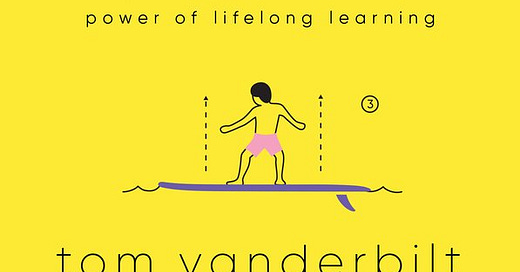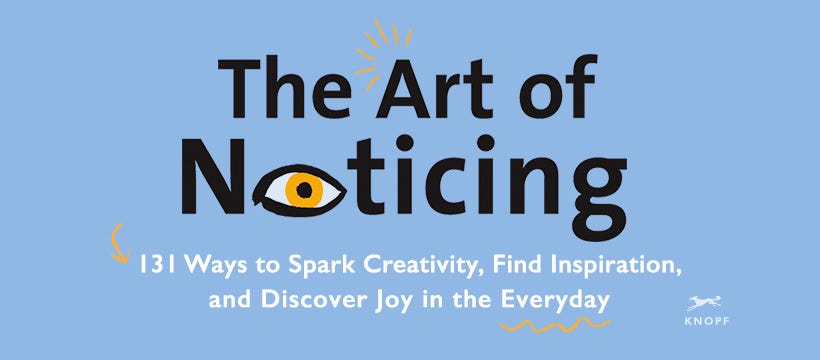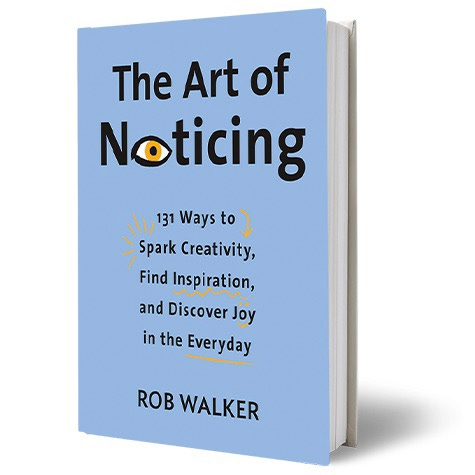TAoN No. 62: How To Get A New Perspective
Learning from Tom Vanderbilt's latest. PLUS: Random Numbers, Another Word We Need, a New Icebreaker & more
The Art of Noticing: 131 Ways to Spark Creativity, Find Inspiration, and Discover Joy In the Everyday offers exercises, prompts, provocations, games and things you can actually do to build attention muscles, stave off distraction, pick up on what everybody else overlooked, and experience the joy of noticing. Indiebound | Amazon | Barnes & Noble | Knopf. This newsletter offers related news and ideas and noteworthy projects that have come along since I finished the book. ****Subscribe or unsubscribe at: robwalker.substack.com.****
Learn A New Perspective
Last issue I mentioned friend of TAoN Tom Vanderbilt’s new book, Beginners: The Joy and Transformative Power of Lifelong Learning, in which he recounts his experiences learning a series of new skills in his 40s: chess, singing, surfing, drawing, and juggling.
You can guess why I’m so into this: Learning new skills is bound built attention muscles. I’ve known Tom for years (and been a fan far longer), and he’s always been great at noticing things others missed. So I asked him: If he had to give an assignment that might help or encourage others to get a little better at noticing, looking, paying attention, what would it be? His reply:
“One approach I sometimes take, to help me notice things or really just for fun, is to try and look at something as an [insert profession here] would. This is a bit inspired by Geoff Manaugh’s book on burglary and the city. So for example if you walked through a shopping mall, what things in the environment would stand out to a thief? Sometimes you don’t really know, but even guessing enhances looking.
This approach, as it happens, also came up in my own book as I tried to learn new skills, which is also really about noticing the world differently.
Learning to draw famously changes the way you look at the world; it trains you not to see things as categorical objects but the way they actually look — an ear that really looks more like a seahorse. Learning to surf is in part knowing how to ‘read’ a wave, to see if a shoulder is rideable, to discern good waves from bad amidst a field of sunlight-filled glare, to look past a wave to see what else might be coming. Learning to sing changes the way you hear music; you’re paying attention to breath control, to phrasing, to a singer’s particular choices in a passage. Learning to play chess, as you get better you stop focusing so much on individual moves and begin to see larger strategic possibilities at play. A master craftsman will see errors where we simply see a beautiful object.
While there’s a riff in The Art of Noticing about trying to “see” through others’ perspectives (a historian, a vandal, a child), Tom’s approach takes the idea to another level with the shift from thought experiment to the participation. And there is much more to Beginners — on learning from failure, embracing dilettantism, connecting with new people, etc. You can get a solid overview via this interview on Think, a public radio show out of Dallas that I enjoy. It will definitely make you want to devote yourself to learning a new skill. Much more on Tom’s site.
(Full disclosure, we have the same publisher — but they had nothing to do with this!)
As a final note: I also asked Tom if he had any personal noticing rituals or habits:
“One habit I have, meeting someone new or traveling somewhere new, is to really fixate — and remember — early impressions. What strikes you about a place you’re new to, about someone you’ve just met? Because the longer you spend time with them, the harder it’ll be to notice those things. I almost think we have a “window of noticing” that’s open in the beginning and, while it doesn’t completely close, it gets fogged up by familiarity.”
I had never thought about this, but it strikes me as on point, and wise. The fog of familiarity is an idea I’m going keep pondering. Thanks, Tom!
Numbers Game
In recent weeks I’ve become inexplicably addicted to David Lynch’s online series, “Today’s Number Is …”
Every episode (if that’s the right word) is the same. Lynch holds up a jar of 10 balls, each marked with a number. “Swiiiirl the numbers,” he says. Then he picks a ball and announces what today’s number is — sort of like lotto drawings on the local news. Finally the screen cuts to text: “What Will Tomorrow’s Number Be?” The whole thing lasts less than a minute. Here’s today’s:
I find it strangely soothing. And I love the comments. (People predicting the number, or opining about it.)
So mostly I’m endorsing this as a weird distraction. And also as a creative inspiration — evidently started as a pandemic-era effort, it has managed to engage an audience despite considerable (ridiculous) constraints. (I am also a fan of Lynch’s morning weather report, a brilliant example of making something fun from something totally banal.) Here’s a Guardian article about the Number series. Here’s the link to Lynch’s YouTube channel, where you can find both the Number and weather series, and other stuff.
But … also … I am finding that kind of want to do something with each day’s number. That way, when I watch every day, there’s a consequence or outcome of some kind … like how many minutes I’ll spend sitting quietly, doing nothing? The number of birds I’m required to take note of that day? Something else?
Basically I want this to convert into some kind of low-stakes Dada-style chance prompt. Any ideas?
Need A Word For …
Need A Word For … is an exercise in paying attention to phenomena you encounter — sensations, states between states, feelings, slippery things — that could be named, but don’t seem to be. More here and here. This week’s submission is from reader Mirja via the comments:
I am searching for a word for the lovely feeling when I am very cold and approach a front door and know it will be warm once I get inside. The same feeling as when I’m freezing and arranging logs in the fireplace but haven’t yet lit them, so I am still very cold, but feeling safe, knowing I will be nice and warm very soon.
That is lovely. Thanks Mirja!
If you have a response (maybe there IS a word for this?), leave it in the comments.
Or submit your own example!
Icebreaker Of The Week
Noticing is about other people, too. The Icebreaker series aims to help with that. There’s a central collection spot for all the icebreakers to date, here. || There’s also an Icebreaker Slack app, here. (Back story on that here.)
This week’s icebreaker comes from reader Jessica:
What is your earliest childhood memory? If it’s something "mundane," why do you think it stuck in your memory? If it’s something unusual/unique, what do you remember most vividly about it?
Jessica explains that this came up in a “reunion with my mates” a few months back that stretched into an eight-and-half-hour hangout. This question stood out because “I got to peek into a part of them from way before we even met.” Fun one — I especially like those add-on questions that encourage the conversation to get a bit deeper. Thanks Jessica!
As usual, I’m still working through the backlog of icebreaker submissions, but as always, I want more:
Send your favorite icebreaker (whether you made it up or found it elsewhere) to consumed@robwalker.net
In Other News
I’ve started a new series over at Marker, the Medium publication I work for: “Object of the Week” is scheduled to run on Thursdays, and aims to plumb the zeitgeist by exploring who is consuming what and why. First up: a look at Capitol Hill riot merch.
I’ve also started another series at Marker: “Everyday Design Icons,” planned to run once a month, is a deep dive on an everyday object so familiar we hardly notice it, but whose absence is hard to imagine. First up: The triumph of the lowly PDF.
A recent sound shot:
I recently encountered and really like the work of artist Hope Gangloff.
I recently encountered and really like the work of artist Ida Floreak. (Thanks, OM.)
Never Been Seen is a smart and fun project/tool from The Science Museum. As It’s Nice That explains, it “reveals unseen photographs of objects from [the museum’s] archive, making you the first person in the world to see that object online and offering the joy of random discovery.” Check it out here. Via Amy Santee.
41 reflections on 2020, collected by S/FJ — I know I’m late, but it’s quite a cast, worth it.
Please follow me on Medium at rwalker.medium.com, and check out Marker, the Medium business publication I work for.
Okay that’s it! Next issue in two weeks.
As always, I value your feedback (suggestions, critiques, positive reinforcement, constructive insults, etc.), as well as your tips or stories or personal noticing rituals, and your icebreakers: consumed@robwalker.net. Or use the comments!
Thanks for reading …
rw
P.S. If you enjoyed this, click the heart symbol and share it and/or sign up here: robwalker.substack.com.
Twitter | Medium | RobWalker.net | NB: I use Amazon Affiliate links
All this by Rob Walker PO Box 171, 748 Mehle St., Arabi LA 70032
Unsubscribe Here if you wish.






Need a word for when you enter a zoom room all by yourself. Do I have the wrong room? Do I have the wrong time? Is Zoom down? Am I alone in the universe?
Warmticipation, or warmtici-pay-ay-tion if Carol King sings it :-)